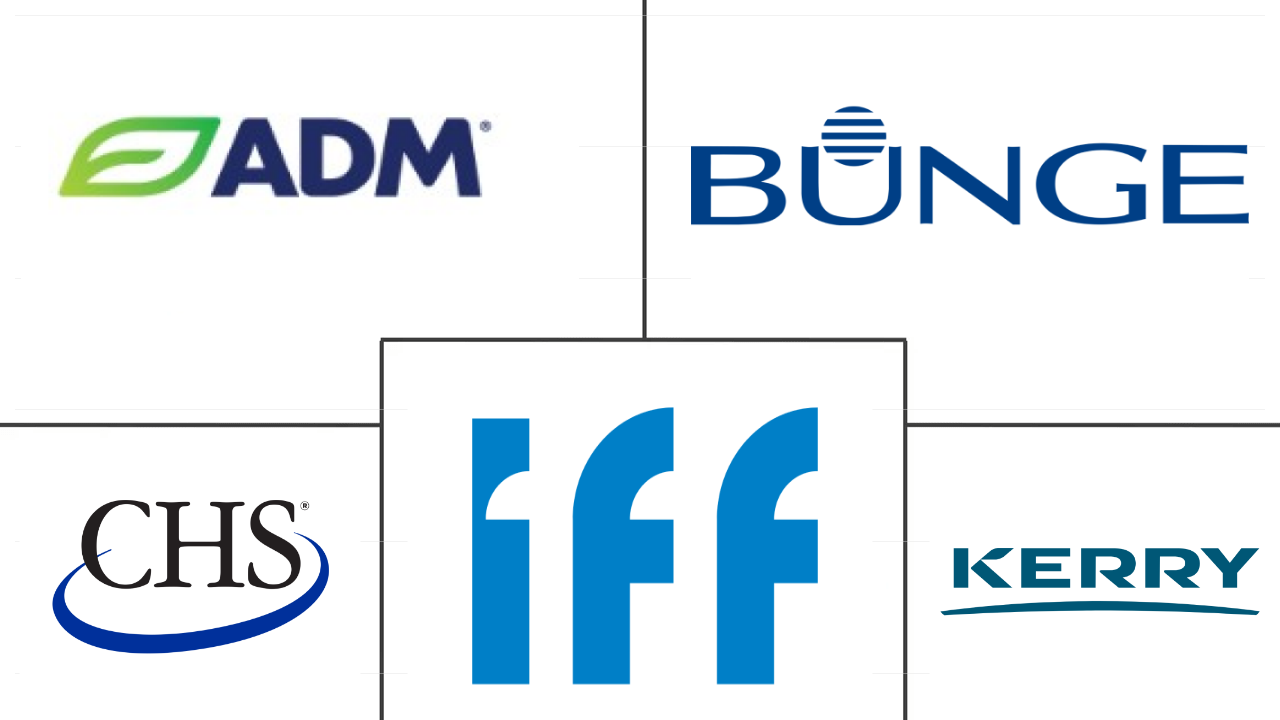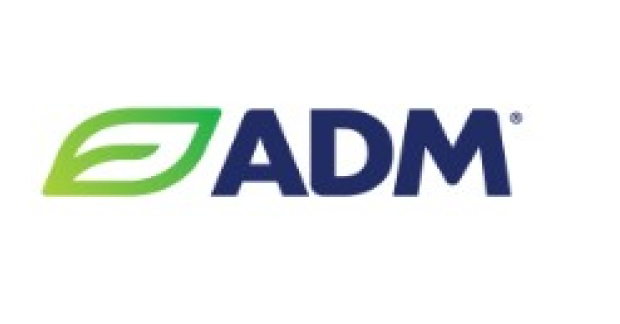Market Size of north america plant protein ingredients Industry
|
|
Study Period | 2017 - 2029 |
|
|
Market Size (2024) | USD 5.04 Billion |
|
|
Market Size (2029) | USD 6.14 Billion |
|
|
Largest Share by End User | Food and Beverages |
|
|
CAGR (2024 - 2029) | 4.03 % |
|
|
Largest Share by Country | United States |
|
|
Market Concentration | Medium |
Major Players |
||

|
||
|
*Disclaimer: Major Players sorted in no particular order |
North America Plant Protein Ingredients Market Analysis
The North America Plant Protein Ingredients Market size is estimated at 5.04 billion USD in 2024, and is expected to reach 6.14 billion USD by 2029, growing at a CAGR of 4.03% during the forecast period (2024-2029).
5.04 Billion
Market Size in 2024 (USD)
6.14 Billion
Market Size in 2029 (USD)
5.63 %
CAGR (2017-2023)
4.03 %
CAGR (2024-2029)
Largest Market by Product Type
67.39 %
value share, Soy Protein, 2023
Soy protein overpowers all the plant protein types due to its high protein content, low viscosity, solubility, etc., which caters to its extensive application in all sectors.
Largest Market by End User
54.58 %
value share, Food and Beverages, 2023
The F&B segment leads the market, mainly driven by the bakery and dairy alternative sectors. The broad functionalities of soy and wheat proteins also boost the F&B segment.
Fastest Growing Market by Product Type
5.58 %
Projected CAGR, Pea Protein, 2024-2029
The pea protein market is anticipated to grow due to the increasing demand from food industry especially from meat substitutes companies.
Fastest Growing Market by End User
6.37 %
Projected CAGR, Supplements, 2024-2029
The rising consumer focus on fitness and sports is anticipated to drive the segment. The increasing preference for soy-based supplements is also boosting the segment's growth.
Leading Market Player
18.20 %
market share, Archer Daniels Midland Company, 2021

Archer Daniels Midland Company holds the largest share of the market. The company focuses on expanding its consumer base and has collaborated with regional clients.
- In 2022, the food and beverage segment witnessed the highest demand, followed by animal feed. The F&B segment recorded a CAGR of 4.63% during the study period. The rising utilization of plant proteins in animal feed and cosmetics has driven growth in recent years. The increase in demand for plant proteins in dairy and meat alternatives is expected to drive the segment during the forecast period.
- The increasing demand for protein functionalities, awareness about protein-rich diets, and new technological developments primarily drive the demand for plant proteins in the market. Among all food and beverage segments, meat alternatives lead the demand in the protein market, owing to the proteins' ability to mimic muscle meat texture. They can also be used for protein fortification in meat-alternative products. In 2022, meat alternatives claimed a 41% share of the overall plant proteins consumed in the food and beverage segment. However, the supplement segment is expected to register the highest demand for plant proteins, with a volume CAGR of 6.12% during the forecast period. The demand is high due to increased daily nutritional requirements as a result of changing lifestyles, especially in the sport/performance nutrition category.
- The meat/poultry/fish and meat alternatives segment represented 19.62% of the total protein consumed in the region in 2022. Textured vegetable protein, made from wheat protein or soy protein, has emerged as a major ingredient for plant-based meat manufacturers since it can closely resemble the sensory properties of meat products. As awareness regarding the adverse effects of consuming meat products increases in the country, manufacturers are looking for new ways to replace meat in their products, and TVP is one of the prime choices.
- The United States remained the largest plant protein-consuming country in the region during the study period. Its share was majorly influenced by the growing demand for plant-based food products amid rising veganism, environmental concerns, and the demand for sustainable protein sources. In 2022, the retail sales of plant-based food products in the United States increased by 27% compared to the previous year. Thus, the surging demand at the retail end is further expected to boost volume sales of plant proteins. Around 61% of consumers in the United States consider plants to be a preferred protein source over animal-based proteins, which is expected to boost market growth.
- On the other hand, Canada and Mexico held a minor volume share in 2022, majorly driven by the F&B and animal feed sectors. The Canadian market is growing in line with the increasing research studies conducted in the segment, boosting consumer interest. In line with the growing market demand, investments are also increasing. In 2021, Protein Industries Canada invested USD 9.7 million in plant protein projects for brands like Daiya and Merit Functional Foods.
- In terms of growth, Mexico is expected to be the fastest-growing country in the regional market, with a projected CAGR of 6.67%, by value, during the forecast period, owing to the growing acceptance of plant proteins among Mexicans, particularly as meat alternatives. The demand from the growing vegan population in the country mainly drives the Mexican plant proteins market. As of 2021, 20% of Mexicans identified themselves as vegetarians or vegans. Mexican food has been traditionally plant-based, and this return to plant-based food has given chefs and restaurants an opportunity to showcase their heritage creatively.
North America Plant Protein Ingredients Industry Segmentation
Hemp Protein, Pea Protein, Potato Protein, Rice Protein, Soy Protein, Wheat Protein are covered as segments by Protein Type. Animal Feed, Food and Beverages, Personal Care and Cosmetics, Supplements are covered as segments by End User. Canada, Mexico, United States are covered as segments by Country.
- In 2022, the food and beverage segment witnessed the highest demand, followed by animal feed. The F&B segment recorded a CAGR of 4.63% during the study period. The rising utilization of plant proteins in animal feed and cosmetics has driven growth in recent years. The increase in demand for plant proteins in dairy and meat alternatives is expected to drive the segment during the forecast period.
- The increasing demand for protein functionalities, awareness about protein-rich diets, and new technological developments primarily drive the demand for plant proteins in the market. Among all food and beverage segments, meat alternatives lead the demand in the protein market, owing to the proteins' ability to mimic muscle meat texture. They can also be used for protein fortification in meat-alternative products. In 2022, meat alternatives claimed a 41% share of the overall plant proteins consumed in the food and beverage segment. However, the supplement segment is expected to register the highest demand for plant proteins, with a volume CAGR of 6.12% during the forecast period. The demand is high due to increased daily nutritional requirements as a result of changing lifestyles, especially in the sport/performance nutrition category.
- The meat/poultry/fish and meat alternatives segment represented 19.62% of the total protein consumed in the region in 2022. Textured vegetable protein, made from wheat protein or soy protein, has emerged as a major ingredient for plant-based meat manufacturers since it can closely resemble the sensory properties of meat products. As awareness regarding the adverse effects of consuming meat products increases in the country, manufacturers are looking for new ways to replace meat in their products, and TVP is one of the prime choices.
| Protein Type | |
| Hemp Protein | |
| Pea Protein | |
| Potato Protein | |
| Rice Protein | |
| Soy Protein | |
| Wheat Protein | |
| Other Plant Protein |
| End User | |||||||||||||
| Animal Feed | |||||||||||||
| |||||||||||||
| Personal Care and Cosmetics | |||||||||||||
|
| Country | |
| Canada | |
| Mexico | |
| United States | |
| Rest of North America |
North America Plant Protein Ingredients Market Size Summary
The North America Plant Protein Ingredients Market is experiencing significant growth, driven by increasing demand for plant-based proteins across various sectors, including food and beverages, animal feed, and cosmetics. The food and beverage segment, particularly meat alternatives, is a major contributor to this growth due to the proteins' ability to mimic the texture of muscle meat, making them ideal for use in dairy and meat alternatives. The rising awareness of protein-rich diets and advancements in technology further bolster the demand for plant proteins. The supplement segment is also witnessing heightened interest, especially in sports and performance nutrition, as consumers seek to meet their daily nutritional needs through plant-based sources. The market is characterized by a shift towards sustainable and environmentally friendly protein sources, with a growing number of consumers in the United States and Canada preferring plant-based proteins over animal-based ones.
The United States leads the region in plant protein consumption, influenced by the increasing popularity of veganism and the demand for sustainable food options. The market is supported by substantial investments and innovations, with companies like Protein Industries Canada investing in plant protein projects to meet the rising consumer demand. Mexico is emerging as a fast-growing market, driven by the acceptance of plant proteins as meat alternatives among its population. The region's robust agricultural output, particularly in soybeans and wheat, supports the supply of raw materials for plant protein production. The market is moderately consolidated, with major players like Archer Daniels Midland Company and Bunge Limited dominating the landscape. Recent developments, such as the introduction of novel rice proteins and the expansion of production facilities, highlight the industry's commitment to meeting the growing demand for plant-based meat substitutes and other applications.
North America Plant Protein Ingredients Market Size - Table of Contents
-
1. MARKET SEGMENTATION (includes market size in Value in USD and Volume, Forecasts up to 2030 and analysis of growth prospects)
-
1.1 Protein Type
-
1.1.1 Hemp Protein
-
1.1.2 Pea Protein
-
1.1.3 Potato Protein
-
1.1.4 Rice Protein
-
1.1.5 Soy Protein
-
1.1.6 Wheat Protein
-
1.1.7 Other Plant Protein
-
-
1.2 End User
-
1.2.1 Animal Feed
-
1.2.2 Food and Beverages
-
1.2.2.1 By Sub End User
-
1.2.2.1.1 Bakery
-
1.2.2.1.2 Beverages
-
1.2.2.1.3 Breakfast Cereals
-
1.2.2.1.4 Condiments/Sauces
-
1.2.2.1.5 Confectionery
-
1.2.2.1.6 Dairy and Dairy Alternative Products
-
1.2.2.1.7 Meat/Poultry/Seafood and Meat Alternative Products
-
1.2.2.1.8 RTE/RTC Food Products
-
1.2.2.1.9 Snacks
-
-
-
1.2.3 Personal Care and Cosmetics
-
1.2.4 Supplements
-
1.2.4.1 By Sub End User
-
1.2.4.1.1 Baby Food and Infant Formula
-
1.2.4.1.2 Elderly Nutrition and Medical Nutrition
-
1.2.4.1.3 Sport/Performance Nutrition
-
-
-
-
1.3 Country
-
1.3.1 Canada
-
1.3.2 Mexico
-
1.3.3 United States
-
1.3.4 Rest of North America
-
-
North America Plant Protein Ingredients Market Size FAQs
How big is the North America Plant Protein Ingredients Market?
The North America Plant Protein Ingredients Market size is expected to reach USD 5.62 billion in 2025 and grow at a CAGR of 4.19% to reach USD 6.90 billion by 2030.
What is the current North America Plant Protein Ingredients Market size?
In 2025, the North America Plant Protein Ingredients Market size is expected to reach USD 5.62 billion.

